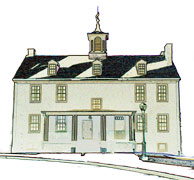




 | | | ||
 | | |||
 | | | | |
 | | |||
 | | |||
| LAND DEVELOPMENT AND POPULATION In 1880, 6,287 people lived in the township; in 1980 about nine times that number. The population density in 1884 was 266 persons per square mile; in 1980, it was 2,556. By the 1970s, the population had begun to decline. The township had been a choice location for estates since colonial times, and the construction of the Pennsylvania Railroad's Main Line encouraged many wealthy city residents, some of them railroad officials, to build estates in the late nineteenth and early twentieth centuries. Alexander J. Cassatt, a PRR president, built Cheswold in Haverford in the late nineties; Joseph Sinnott, of Moore and Sinnott, distillers, built Rathalla in; 1891; Percival Roberts, president of the Pencoyd Iron Works, built Penshurst in Penn Valley in 1903 and razed it when the township made plans to build a trash disposal plant in Belmont Hills in the forties. As local train and trolley systems increased their service and roads improved, the middle-class exodus from the city began, creating a demand for appropriate housing. The variety of choices available to prospective home-buyers in 1911 is seen in the Main Line Residential and Business Directory 1911-1912. Cynwyd is described as 6.2 miles from the city with "houses of the most modern type," with a public garage but no hotels. A real estate development near the station had thirty houses ranging in price from $10,000 to $80,000. Wynnewood, 7.6 miles from the city, was an "essentially suburban station of large places and magnificent estates." Wynnewood Manor, developed by Walter Basset Smith, had many architectural styles with prices around $10,000. The progression of change can be seen in the history of Pencoyd, an estate of 150 acres settled by John Roberts in 1683, located in what is now Bala near the present-day Marriott Hotel and WCAU studios. In 1892, George B. Roberts, the sixth proprietor, dug a 150-foot well and installed a deep well pump to supply water through pipes to the house and outbuildings. At about the same time, the house was wired for electricity, and incandescent bulbs supplanted the gaslights with Welsbach mantles. Pencoyd remained a working farm until 1929 and retained its rural setting through World War II. By the close of the 1950s the land had descended to heirs or been sold, leaving about twenty acres actually belonging to Pencoyd House. The earliest residential development in the township was along or near Lancaster, Montgomery, and City avenues, locations of high-density population today. Most suitable large landholdings have been developed, with Gladwyne's Foerderer estate one of the last to go. In 1980 the township approved plans to build 107 luxury townhouses, each to cost about $270,000-$285,000, on this ninety-acre tract. A century ago 195 farms were in Lower Merion; today only 2 percent of the land is used for farming. More than half of the land is used for residential purposes: 53 percent for single homes, 2 percent for apartments, 1 percent for two-family homes. Individuals and families occupy 7,000 apartments and 15,400 houses. A trend toward conversion of rental apartments to condominiums is controlled by a township ordinance; 326 units were converted by 1980. The housing vacancy rate is 2.3 percent as compared with the national average of 4 percent. Statistics from the Lower Merion Township Comprehensive Plan, 1979, indicated that Lower Merion families were growing smaller: in 1960 there were 3.2 persons per family; in 1970, 2.9. Close to 40 percent of residents were over forty-five years old, and the median age was 37.6. More than half the population has had college training, and one-third has had four years or more. Of the 25,107 employed residents in the township in 1970, 900 were in construction; 4,268 in manufacturing and other industries; 456 in transportation; 547 in communications; 1,542 in wholesale trade; 3,907 in retail trade; 2,432 in finance and real estate; 1,007 in business and repair services; 1,502 in personal service; 2,315 in health services; 3,294 in educational services; 2,318 in other professional services; and 619 in public administration. Almost half of the workers are in professional-technical or managerial positions; another quarter is in sales or clerical jobs. Lower Merion's proximity to Philadelphia permits considerable interchange between the two areas. In 1970, 39 percent of employed Lower Merion residents worked in Philadelphia. In 1970, 6.7 percent of the population was foreign born, listing places of birth in Europe, Canada, Mexico, Cuba, and South America. In 1980 about 94 percent of the population of 59,651 was white; about 4.5 percent was black; 1 percent of Asian origin and l percent of Spanish descent. Many black families are longtime residents whose forebears, after being freed from slavery, settled where they could find work in the large and wealthy homes in the area. In 1930 they composed 4.4 percent of the population; in 1960, 4.9 percent. For the most part the black families live in South Ardmore and sections of Bryn Mawr. Irish immigrants arriving in the late nineteenth century settled where they could find jobs as railroad workers, coachmen, cooks, gardeners, and housemaids. Italian families gravitated toward Ardmore, Ashland, and Bryn Mawr in the late nineteenth and early twentieth centuries. Many of the men were stonemasons who found work with the builders constructing middle-class homes, churches, and schools. In the forties and fifties many Jewish families moved from the city, seeking not jobs but the more attractive features of suburban life: more space, more natural beauty, and better schools. In the 1960s and 1970s Asian refugees, mostly Koreans and Vietnamese, made their way to the area. Although boundaries in the suburbs of the township may seem nebulous to many, the various communities have a strong sense of identity. Civic associations are well supported and active. |